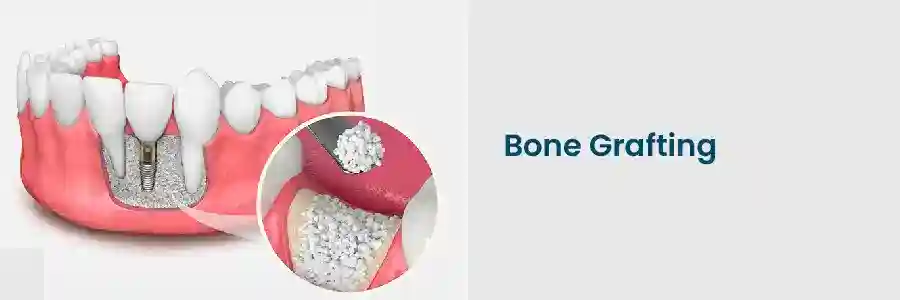- Cardiology 84
- Dermatology 45
- Endocrinology 33
- ENT 16
- Fertility 190
- Gastroenterology 78
- General-Medicine 81
- Gynecology 80
- Hematology 19
- Infectious-Diseases 33
- Neurology 52
- Oncology 34
- Ophthalmology 23
- Orthopedics 69
- Pediatrics 31
- Procedure 23
- Public-Health 144
- Pulmonology 59
- Radiology 8
- Urology 68
- Wellness 161
- Woman-and-child 77

What is Bone Grafting?
Bone grafting is surgery to place new bone or bone substitutes into the spaces around a broken bone or bone defect. As effective as bone grafts might be in repairing arms and legs, bone grafts are also regularly placed in dental treatments. Dental bone grafts are placed in the areas of the jaw where bone loss has occurred to add bone density and volume.
Without adequate bone within the jaw area, individuals are susceptible to all sorts of oral health issues. Teeth may shift, infections might arise, and the jaw will be vulnerable to breakage.
Why Is Bone Grafting Recommended?
The doctor may recommend bone grafting for the following conditions:
- Bone diseases like bone cancer
- Rebuilding a fractured bone
- Fusing bones of a joint
- Treating a fracture that is not healing
- Replacing a missing tooth(dental implant surgery)
- A previous fracture that has not healed properly
- Filling gaps in bones caused due to tumors or cysts
- Expediting bone growth
- Alveolar bone grafting to treat cleft palate
Secure your health with a second opinion. Make informed decisions and book your appointment today!
Get A Second OpinionWhat Are The Different Types of Bone Grafts?
There are several bone grafting methods, including:
Allograft
This method makes use of another person's bone tissue (donor). The bone tissue is cleaned and processed (sterilized) to ensure the recipient's safety. It is commonly used in spinal fusion surgery. It serves as a framework for the development of healthy bone tissue.
Autograft
A portion of your own bone tissue is used in an autograft. The tissue is usually derived from the part of your hip bone (iliac crest). The surgeon makes a cut to obtain the bone tissue. The advantage of using your tissue is that it increases the likelihood of successful fusion. However, the amount of bone tissue that can be collected is limited. You may also experience pain at the site where the bone graft is collected.
Bone Marrow Aspirate
A marrow is a spongy substance found within bones. It contains stem cells, which can help heal fractured bones. The surgeon obtains bone marrow from the hip bone(iliac crest) with a needle. This bone marrow aspirate is used alone or in combination with other bone grafts to improve bone healing after allograft surgery.
Synthetic Bone Graft
This graft uses synthetic materials made from various porous substances. Some also contain proteins that promote bone development.
Ready to take control of your health journey? Book your appointment now and start your path towards wellness today!
Book an AppointmentWhat Are The Risks of Bone Grafting?
All bone grafting procedures come with risks. They include:
- Blood loss
- Infection
- Problems with bone healing
- Chronic pain
- Fractures
- Screws and plates fail to hold the graft in place
- Scarring
Citations
Bone Graft by MountsinaiBone Graft Types by Interchopen
Bone Grafting by Hopkins Medicine
Frequently Asked Questions
Bone grafts can be taken from different parts of your own body (autologous), cadaveric bone obtained from bone banks (allograft), or synthetic sources (alloplasts) with similar mechanical properties to bone.
No, bone grafts taken from a cadaver are made sterile using international standardized protocols. Hence, infections do not occur because of the graft.
As with all surgical procedures, there is a risk of pain, swelling, bruising, bleeding, and infection. Minimal chances of graft rejection do exist. All these complications can be avoided when proper diagnostic, sterilization, and surgical protocols are followed.
The length of the procedure is determined by the complexity of the case and the size of the bone that must be harvested or fixed. The majority of bone graft surgeries take between 1-2 hours.
Bone grafts are most often needed to heal bone fractures. A doctor may recommend that a patient get a graft if they believe that a fracture won't heal well or if a previous fracture that was not treated with a graft has not healed well on its own.
Bone grafting can involve discomfort, but pain is typically managed with anesthesia and pain-relief medications. The level of discomfort varies depending on the individual and the extent of the procedure.
Bone grafting costs can vary widely depending on the type of graft, location, and healthcare provider. Generally, it can be costly due to surgical fees, materials, and potential hospital charges.
Bone grafting can be performed at any age, depending on the medical necessity and condition. It is commonly used in adults to treat fractures that won't heal properly or in children to address developmental bone issues.

- Cardiology 2132
- Dermatology 168
- Endocrinology 135
- ENT 97
- Fertility 217
- Gastroenterology 232
- General 478
- General-Medicine 1685
- Gynecology 169
- Hematology 85
- Infectious-Diseases 208
- Neurology 207
- Oncology 345
- Ophthalmology 65
- Orthopedics 187
- Pediatrics 83
- Procedure 72
- Public-Health 209
- Pulmonology 126
- Radiology 13
- Second Opinion 311
- Urology 294
- Wellness 600
- Woman-and-child 447
- Others 10217
Related Blogs
If you have any questions, please fill out the enquiry form or call us, and we will get back to you promptly.
040-68334455